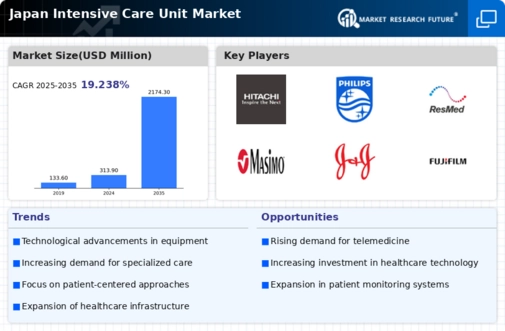Focus on Quality of Care
The growing emphasis on quality of care in Japan significantly impacts the intensive care-unit market. Healthcare providers are increasingly prioritizing patient safety and satisfaction, leading to the implementation of best practices in intensive care settings. Accreditation bodies are setting higher standards for ICUs, which encourages hospitals to invest in quality improvement initiatives. This focus on quality is reflected in the rising demand for specialized training for ICU staff and the adoption of evidence-based protocols. As hospitals strive to achieve accreditation and improve their performance metrics, the intensive care-unit market is likely to benefit from enhanced funding and resources dedicated to quality care initiatives.
Increase in Chronic Diseases
The prevalence of chronic diseases in Japan is a substantial factor influencing the intensive care-unit market. Conditions such as diabetes, cardiovascular diseases, and respiratory disorders are on the rise, necessitating advanced critical care solutions. Reports indicate that nearly 30% of the Japanese population suffers from at least one chronic illness, leading to increased hospital admissions and longer ICU stays. This trend compels healthcare providers to enhance their intensive care capabilities, ensuring they are equipped to manage complex cases effectively. As a result, The intensive care-unit market is likely to expand due to the need for specialized care and advanced monitoring technologies. This expansion is necessary to cater to the growing patient population with chronic health issues.
Rising Healthcare Expenditure
The increasing healthcare expenditure in Japan is a pivotal driver for the intensive care-unit market. As the government allocates more funds towards healthcare, the budget for critical care facilities expands. In 2025, healthcare spending is projected to reach approximately $500 billion, with a significant portion directed towards enhancing intensive care services. This financial commitment facilitates the acquisition of advanced medical technologies and the expansion of ICU capacities. Furthermore, the emphasis on improving patient outcomes and reducing mortality rates in critical care settings aligns with the national healthcare policies. Consequently, the intensive care-unit market experiences growth as hospitals invest in state-of-the-art equipment and skilled personnel to meet the rising demand for intensive care services.
Technological Integration in ICUs
The integration of cutting-edge technologies in intensive care units is transforming the landscape of critical care in Japan. Innovations such as telemedicine, artificial intelligence, and advanced monitoring systems are becoming increasingly prevalent. These technologies enhance patient management and improve clinical outcomes, thereby driving the growth of the intensive care-unit market. For instance, the adoption of AI-driven analytics in ICUs has shown to reduce response times and improve decision-making processes. Hospitals are investing heavily in these technologies, with expenditures on ICU equipment expected to rise by 15% annually. This technological evolution not only optimizes resource utilization but also elevates the standard of care provided in intensive care settings.
Government Initiatives and Policies
Government initiatives aimed at improving healthcare infrastructure play a crucial role in shaping the intensive care-unit market. Policies that promote the establishment of new ICUs and the upgrading of existing facilities are currently being implemented. The Japanese government has set ambitious targets to enhance healthcare accessibility and quality, which includes increasing the number of ICU beds by 20% over the next five years. Such initiatives are likely to stimulate investments in the intensive care-unit market, as hospitals seek to comply with regulatory standards and improve patient care. Additionally, funding programs for training healthcare professionals in critical care further support the market's growth, ensuring a well-equipped workforce to meet the demands of an evolving healthcare landscape.






















Leave a Comment